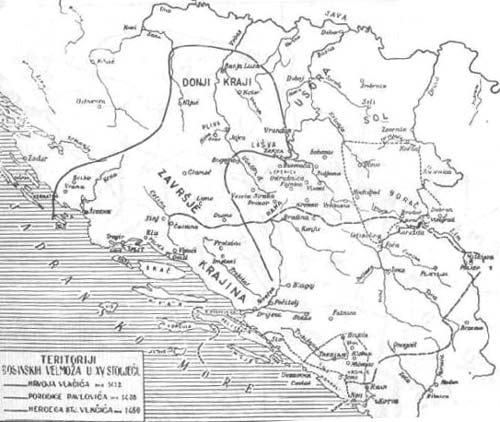Web catalog
Most read
Most read last 7 days
Most Discussed
Top rated
Statistics
- Total registered users: 10041
- Total articles: 23656
- Total comments: 2087
- Last entry: Kebo presenting evidence that Izetbegovic brought mujahideen to Bosnia
- Last update: 11.01.2019. 23:44
The necessity for communication
Written 27.11.2009. 12:05
 The breakout from the initial core ran parallel with the development of an independent Bosnian state. Bosnia had expanded past the midpoint of the river Drina, towards the Serb lands, perhaps as early as during the reign of Ban Kulin (towards the end of the 12th century), but definitely during the reign of Ban Matej Ninoslav (mid 13th century). Crucial for Bosnian development was its territorial drive towards west, south-west and further south to the coast, especially toward the eastern Adriatic coast, all these being Croatian regions. Further Bosnian territorial drives in 13th and 14th centuries, the annexation of parts of the Croatian kingdom (Donji Kraji and Zavrsje) had a twofold effect. First, Bosnia now included significant parts of the Croatian kingdom, and secondly, Bosnia was now in a close geopolitical and economic relationship with the surrounding Croatian lands.
The breakout from the initial core ran parallel with the development of an independent Bosnian state. Bosnia had expanded past the midpoint of the river Drina, towards the Serb lands, perhaps as early as during the reign of Ban Kulin (towards the end of the 12th century), but definitely during the reign of Ban Matej Ninoslav (mid 13th century). Crucial for Bosnian development was its territorial drive towards west, south-west and further south to the coast, especially toward the eastern Adriatic coast, all these being Croatian regions. Further Bosnian territorial drives in 13th and 14th centuries, the annexation of parts of the Croatian kingdom (Donji Kraji and Zavrsje) had a twofold effect. First, Bosnia now included significant parts of the Croatian kingdom, and secondly, Bosnia was now in a close geopolitical and economic relationship with the surrounding Croatian lands. Certainly, Bosnia also absorbed some Serbian regions in the 14th century, as King Tvrtko's Bosnia expanded towards east and south-east, encompassing Upper Podrinje and Polimlje all the way down to Dubrovnik and Kotor hinterland. As was mentioned before, the surrounding and annexed Croatian regions were far more important in Bosnia's development.
Bosnia's territorial enlargement during the reign of king Stjepan II Kotromanic and Tvrtko I was first and foremost directed at the eastern Adriatic coast. Such large changes greatly influenced the relations between Bosnia and the Croatian kingdom. A very strong social current towards the belt of settlements from Zadar to Dubrovnik meant that Bosnia developed strong economic, folk and reflective ties with the Croatian domain. It can be said that Bosnia had a specific role as a border zone, connecting Croatia with the wider Balkan region.
Active economic ties and trade between Bosnia and Croat coastal towns can be observed from as early as reign of Ban Kulin all the way up to the Turkish invasion. Beginning from the "friendship" contract between Ban Kulin and Dubrovnik in 1189, through to the sudden rise in trade that was due to the construction of important landmarks of Split in 1592. Social communication between the Croatian kingdom and Bosnia, first and foremost, meant interaction of the peoples. Migrations, especially from Bosnia towards the Adriatic coast and running the other way, from Dalmatian towns into Bosnia - resulted in an exchange of ideas and concepts (dualist heresy, language and art).
Bosnia's unique social development was a legacy of eastern and western influences. Influences eminating from the east were an initial guide in development, but from the 12th century onwards, western influences had become dominant. Heretic, dualist ideas from the east were the main factor in the creation of a "Bosnian church", the strongest factor in Bosnia's uniqueness, It must also be said that from the outset, the western church had a very strong influence in Bosnia. Indeed, even the heretic "Bosnian church" was created within the jurisdiction and the embrace of the western church. As of the 14th century, an important factor in the spiritual and social development of Bosnia was the activity of the Franciscan order. Bosnian language and script was also a combination of western and eastern influences. The initial glagolitic base had been supplemented with the use of Cyrillic script, but with a Bosnian adaptation. Morphologic simplicity, folk grammar, the "ikavica" dialect and the visual differences mean that the Bosnian version of Cyrillic was clearly different to the eastern version. The two Cyrillic zones - eastern and western, did of course have the same origin, but their spiritual use and role in the society were quite different.
























































 Kontaktirajte nas
Kontaktirajte nas
No comments